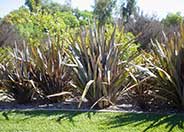
Common name:Blue Palo Verde
Botanical name:Cercidium floridum
This desert tree has an upright habit and can reach 30' high and wide. It can grow moderately fast with irrigation, however, it can be considered drought tolerant. Trees bloom profusely in spring with clusters of golden-yellow blossoms.

Common name:Dusky Chief Flax
Botanical name:Phormium tenax 'Dusky Chief'
This plant will grow 5-10' high x 3-6' wide and has unique foliage that varies in color. It produces deep purple flowers that have a coral edge.

Common name:Incana Cranesbill
Botanical name:Geranium incanum
Geranium incanum is grown as a trailing or mounding perennial to a size of 1' tall, spreading by underground runners to cover relatively large areas if healthy. Its foliage has a wispy, ferny texture. The dark, rosy violet flowers can appear almost all year in areas of mild climates. The plant needs good drainage, and most suffer die back in cold winters. Proper growth conditions include sun with little or no summer watering. -Monterey Bay Nursery

Common name:Society Garlic
Botanical name:Tulbaghia violacea
This clumping perennial will grow less than 1' tall and has narrow, blue green leaves. Clusters of lavender flowers bloom in spring and summer. Leaves and flowers have a distinct onion or garlic smell if crushed.

Common name:Catmint
Botanical name:Nepeta X faassenii
Nepeta faassenii makes soft, gray green, undulating mounds that are 1.5' high when blooming. The small leaves are attractive to cats. This perennial has lavender blue flowers in late spring and early summer.

Common name:Huachuca Agave
Botanical name:Agave parryi v. huachucensis
This Agave grows slowly to 2' by 2'. It is lump forming with dense rosettes. It has short gray leaves with dark thorns on the margins. This is the largest of the subspecies of parryi with leaves 2' long. It is native to parts of AZ and is more robust, with larger leaves and broader panicles and larger flowers than the species. It is primarily found in oak and pine woodlands.-Mountain States Nursery
The Magic of Mulch
In the natural world the endless cycle of birth, growth, decay, death and rebirth flows throughout the seasons. Plants die, leaves fall and new growth springs up in its place. Nothing is lost and the fallen leaves and dead plants decay into the soil, enriching it for the next generation of growth.
Click in the green box for more information
| Designer: | Cal Southwest Garden |
Photographer: GardenSoft |
Soils and Compost:
Maintain a two to four inch layer of mulch on the soil surface to reduce weeds, infiltrate rain water, and reduce compaction.
Water Saving Tip:
Adjust sprinklers to avoid watering sidewalks and driveways.
Integrated Pest Management:
Develop healthy soil for plants that are vigorous and naturally pest-resistant.
